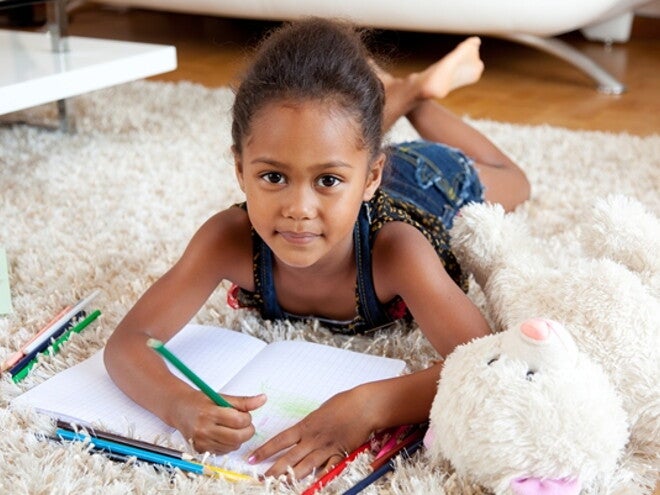
63 Months Milestone
Your child can now learn to cut out more complex shapes, such as figures, while staying within ½ cm of the line. Children now typically learn to colour between the lines fairly accurately. Their supporting hand stabilises the paper, a tripod finger grip (thumb, forefinger and middle finger work together) and the wrist of the writing hand are supported on the table.
Learning to draw a triangle with fairly straight lines that meet at the corners is a developmental milestone that typically emerges at this age. This is significant as it is a sign that your child has learnt to visualise a mental image of how three lines can be connected to create a triangle. Before now, they could identify triangles, but not draw them.
From a visual processing perspective, being able to draw a triangle is an indicator of being ready to learn to write.
Pump up the pattern
Being able to string beads or build a tower in a blue-red-blue-red sequence doesn’t seem to be an intellectual feat, but it’s an impressive milestone on the path to intellectual learning readiness. This is because it involves looking at information analytically – from a different perspective.
The first pattern that children can recognise and create is called ABAB
Many two-year-olds can help a parent build a multi-coloured tower by handing over a “blue block, red block, blue block, red block” on command.
Doing this teaches many other skills, but two-year olds don’t truly understand what it means to create a pattern.
Grasping the basic premise of what pattern following means
Pattern following is a milestone that is typically reached at the age of five. You will know that your child has grasped this when they spontaneously point out ABAB patterns in everyday situations. They may notice the “purple, blue, purple, blue” stripes on a shirt or the “long, short, long, short” pattern that one may see on a wooden fence.
More complicated patterns: AABAAB, ABCABC and even ABACABAC
Once children reach the ABAB pattern milestone, it is easy for them to master more complicated patterns.
Here’s what you can do to help:
- Play with movement patterns. These represent your child’s first real experience of creating patterns. Have fun swaying from side to side to the rhythm of music, as well as marching “left, right, left, right” and skipping “step, hop, step, hop.”
- Create new ABAB movement patterns. A different ABAB pattern could be “jump, clap, jump, clap.” Ensure your child has truly internalised the ABAB pattern before introducing more complicates ones. This is akin to teaching a child to walk before they can run.
- Play with sound patterns. When your child can clap to the rhythm of music, have fun producing different sounds such as banging a spoon on a “box, pot, box, pot.”
- Organise objects according to ABAB patterns. Use toys and everyday objects to create the ABAB pattern. You could use different coloured blocks “blue block, red block, blue block, red block” or cutlery “spoon, fork, spoon, fork.” Start the pattern using four objects, then “read” what you’ve built from left to right while placing a finger on every object. Encourage your child to complete the pattern.
Benefits of teaching this important developmental skill:
- Pattern following prepares children to learn to read and write. Especially when they recreate patterns while following printed instructions from left to right.
- These activities provide important building blocks for learning to play an instrument or do mathematics. Pattern following trains their brains to use rules, to organise and work with units.
- Pattern following also puts children on the path towards creative observation. It teaches them to pay attention to the way things relate to each other and to notice patterns where they would otherwise only see chaos.
As Steve Jobs once said: “Creativity is just connecting things.”
Tip: Copycat Colouring
This is a fun game that develops a child’s ability to process visual information. It’s easy to play when you’re waiting in a restaurant, or wherever you have a piece of paper and pens or crayons available.
Draw two identical grids with nine squares in each, like a noughts and crosses diagram with a frame around it. Give one grid to your child and keep the other one. Then, play a game where you colour a block and your child imitates what you did on their grid, one block at a time. Take turns to be the leader.
Add a twist by throwing a dice to see how many blocks the leader may colour before their turn is over.